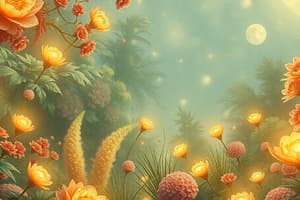Podcast
Questions and Answers
What is the average age for menarche?
What is the average age for menarche?
12.4 years
What is the main hormone contributed to the development and maturation of the ovarian follicle?
What is the main hormone contributed to the development and maturation of the ovarian follicle?
- GnRh (correct)
- FSH (correct)
- Testosterone
- Estrogen
Thelarche is the onset of ______ development.
Thelarche is the onset of ______ development.
breast
An irregular menstrual cycle for the first 2 years after menarche is considered normal.
An irregular menstrual cycle for the first 2 years after menarche is considered normal.
What occurs during the Luteal Phase?
What occurs during the Luteal Phase?
What is dysmenorrhea?
What is dysmenorrhea?
Match the following conditions with their definitions:
Match the following conditions with their definitions:
Cramps during menstruation are caused by the presence of prostaglandins.
Cramps during menstruation are caused by the presence of prostaglandins.
What is a common symptom experienced before menstruation?
What is a common symptom experienced before menstruation?
What is gametogenesis?
What is gametogenesis?
What is the function of the Leydig/Interstitial Cells?
What is the function of the Leydig/Interstitial Cells?
What are the two types of cells found in the seminiferous tubules?
What are the two types of cells found in the seminiferous tubules?
What is the main function of the scrotum?
What is the main function of the scrotum?
The urethra carries urine and semen at the same time.
The urethra carries urine and semen at the same time.
What does inhibin do?
What does inhibin do?
What is the primary site for sexual arousal in the female reproductive system?
What is the primary site for sexual arousal in the female reproductive system?
The process of sperm maturation occurs in the ________.
The process of sperm maturation occurs in the ________.
What triggers the onset of spermatogenesis?
What triggers the onset of spermatogenesis?
Which of the following structures secretes alkaline mucus-like fluid?
Which of the following structures secretes alkaline mucus-like fluid?
What hormone promotes secondary sex characteristics in males?
What hormone promotes secondary sex characteristics in males?
Match the following glands with their functions:
Match the following glands with their functions:
How many days does it take for the zygote/fertilized egg to travel to the uterus?
How many days does it take for the zygote/fertilized egg to travel to the uterus?
Which of the following are regions of the uterus?
Which of the following are regions of the uterus?
What are the layers of the uterus?
What are the layers of the uterus?
The hymen fully covers the vaginal opening.
The hymen fully covers the vaginal opening.
Which hormone is responsible for milk production?
Which hormone is responsible for milk production?
What is the function of Human Chorionic Gonadotropin (hCG)?
What is the function of Human Chorionic Gonadotropin (hCG)?
The hormone that stimulates uterine contractions during labor is called ______.
The hormone that stimulates uterine contractions during labor is called ______.
What hormonal change triggers spermatogenesis in males?
What hormonal change triggers spermatogenesis in males?
During puberty, which physical change is associated with increased testosterone levels in males?
During puberty, which physical change is associated with increased testosterone levels in males?
Estrogen, produced during female puberty, influences which of the following?
Estrogen, produced during female puberty, influences which of the following?
What is the significance of the placenta by the 3rd month of pregnancy?
What is the significance of the placenta by the 3rd month of pregnancy?
Study Notes
Human Reproductive System Functions
- Gametogenesis: Production of gametes; includes oogenesis in females and spermatogenesis in males.
- Fertilization: Union of gametes leading to zygote formation.
- Growth and Nourishment: Supports development of a new individual.
- Hormone Production: Regulates reproductive functions and characteristics.
Male Reproductive System
- Testes: Primary male gonad, responsible for both endocrine (testosterone) and exocrine functions (sperm production).
- Lobules: Divided sections within testes containing seminiferous tubules, where sperm is formed.
- Germ Cells: Differentiate into spermatozoa.
- Sertoli Cells: Nourish germ cells.
- Leydig Cells: Secrete testosterone, found in connective tissue around seminiferous tubules.
External Male Structures
- Penis: Male organ for sexual reproduction and urine excretion, consists of shaft, glans penis, and foreskin.
- Scrotum: Skin pouch that encloses and protects the testes; maintains optimal temperature for sperm production (~3°C below body temperature).
Internal Male Structures
- Epididymis: Coiled tube for sperm maturation and temporary storage.
- Vas Deferens: Transports sperm from epididymis to ejaculatory duct.
- Urethra: Carries urine and semen, divided into prostatic, membranous, and penile urethra.
Accessory Glands
- Seminal Vesicles: Secretes fluid containing nutrients and prostaglandins.
- Prostate Gland: Produces alkaline fluid that enhances sperm motility; can cause urinary obstruction if enlarged.
- Bulbourethral (Cowper’s) Gland: Secretes lubricating fluid that neutralizes acidity in the urethra.
Semen Composition
- Function: Transporting sperm, providing nourishment and protection, and allowing dilution.
- Normal Parameters:
- Sperm count: ~50-150 million/mL.
- Ejaculation volume: ~2.5 mL.
- pH: Alkaline (7.2-7.6).
Spermatogenesis Process
- Begins at puberty, triggered by high FSH levels.
- Sperm cells originate from spermatogonia in seminiferous tubules.
- Undergoes mitosis, meiosis, resulting in four haploid daughter cells from each primary spermatocyte.
- Spermatids mature in the epididymis over ~20 days; final maturation includes capacitation before fertilization.
Male Reproductive Hormones
- GnRH: Stimulates secretion of LH and FSH.
- LH: Stimulates testosterone synthesis; also known as ICSH.
- FSH: Supports spermatogenesis.
- Testosterone: Promotes male secondary sex characteristics.
Female Reproductive System
- Ovaries: Primary female gonads, produce estrogen and progesterone.
- Follicles: Oocytes surrounded by follicle cells that mature into Graafian follicles, which rupture during ovulation.
External Female Structures
- Vulva: Collective term for external female genitalia, including mons pubis, labia majora, labia minora, vestibular glands, and clitoris.
Internal Female Structures
- Uterine Tubes: Convey oocytes; site of fertilization (ampulla).
- Uterus: Hollow organ for implantation and nourishment of fertilized egg; consists of fundus, body, and cervix.
- Three Layers of Uterus:
- Perimetrium: Outermost layer.
- Myometrium: Muscle layer important during labor.
- Endometrium: Inner lining where implantation occurs.### Endometrium Overview
- The endometrium provides a site for implantation of the embryo, featuring a highly vascular layer.
- Ovarian follicles are tiny sac-like structures that hold immature eggs (oocytes).
- Young embryos travel to the uterus and implant in the endometrial lining.
Menstrual Cycle
- If pregnancy does not occur, the endometrial lining sheds during menstruation.
Vagina
- Acts as the reception area for semen during intercourse.
- Serves as a passage for uterine secretions and the fetus during labor.
- The hymen partially covers the vaginal opening and can bleed when ruptured.
Hormones Involved in Female Reproductive Health
- Estrogen (produced in ovarian follicles): Maintains uterine lining for fertilization; includes estradiol, estrone, and estriol.
- Progesterone (produced in the corpus luteum): Also maintains uterine lining, preparing for potential fertilization.
- Human Chorionic Gonadotropin (hCG): Produced by placenta; maintains corpus luteum and increases progesterone during early pregnancy.
- Oxytocin (produced in the posterior pituitary): Stimulates uterine contractions and milk ejection during breastfeeding.
- Prolactin (produced in anterior pituitary): Promotes milk production and the development of mammary glands.
Oogenesis
- Begins during fetal development with around 5 million oogonia formed by the fourth month.
- At birth, females have approximately 2 million primary oocytes that are suspended in the first meiotic division.
- By puberty, around 300,000-400,000 primary oocytes remain, with about 400 continuing to develop and becoming secondary oocytes.
Male Puberty and Changes
- Increased luteinizing hormone levels trigger testosterone production, influencing physical growth, muscle development, and reproductive organ development.
- Features changes like growth of facial and body hair, voice changes, and nocturnal emissions related to spermatogenesis.
Female Puberty and Changes
- Triggered by the release of GnRH from the hypothalamus, leading to FSH and LH release from the anterior pituitary.
- Influenced by estrogen, affecting the development of reproductive structures, fat distribution, and overall maturation.
- Significant changes occur in breast development, widening of hips, and closure of epiphyseal plates.
Puberty Characteristics
- Onset for girls typically occurs between ages 10-14; boys experience changes between ages 12-16.
- Primary sex characteristics involve changes directly related to reproductive organs.
- Secondary sex characteristics involve physiological signs of maturation, including body hair and fat distribution changes.
Concerns and Awareness During Puberty
- Boys may experience gynecomastia, acne, and nocturnal emissions, which are normal developments.
- Girls experience various physical changes due to hormonal fluctuations, influencing body shape and reproductive health.### Physical Changes During Puberty
- Growth spurt typically achieved by age 16, with females reaching 98% of adult height.
- Increase in transverse pelvic diameter occurs during development.
- Thelarche marks the onset of breast development, usually 1-2 years prior to menarche.
- Menarche, the first menstrual period, typically occurs around age 12.4 (range 9-17 years).
- Early menstrual cycles may be irregular as the body establishes ovulation.
- Hormonal fluctuations can increase testosterone, resulting in:
- Enlargement of labia majora and clitoris
- Thicker body hair and increased libido.
Hormonal Phases of the Menstrual Cycle
- Proliferative Phase (Days 6-14):
- Estrogen levels rise; endometrial lining becomes thin post-menstruation.
- GnRh and FSH promote ovarian follicle development, with the graafian follicle secreting estrogen.
- Ovulatory Phase (Day 15):
- Surge in LH triggers the rupture of the graafian follicle, releasing an egg.
- Secretory Phase (Days 15-28):
- Endometrial thickening occurs, characterized by a corkscrew appearance.
- Corpus luteum forms, secreting progesterone to prepare for potential pregnancy.
- Pre-menstrual/Ischemic Phase (Last 2 days):
- Lack of pregnancy causes endometrial artery constriction, leading to lining shedding.
The Menstrual Cycle Overview
- Average menstrual cycle duration is 28 days, with flow lasting 4-6 days.
- Typical menstrual flow is around 30-80ml, characterized by dark red blood and mucus endometrial cells.
- Menstrual cycle phases: Menstruation → Proliferative → Ovulatory → Secretory → Pre-menstrual.
Menstruation Details
- First day of menstruation is marked as the beginning of the new cycle.
- Menses consists of blood from ruptured capillaries, mucin, endometrial fragments, and unfertilized ovum remnants.
Signs Accompanying Ovulation
- Subjective Signs:
- Increased cervical mucorrhea, sharp abdominal pain (Mittelschmerz), and slippery vaginal discharge.
- Objective Signs:
- Changes in basal body temperature and spinnbarkeit of mucus.
Menstrual Health Teachings
- Good hygiene practices are essential.
- Exercise and adequate fluid intake are recommended.
- Dietary advice includes balanced nutrition with reduced salt for bloating relief.
- Emotional wellness tips: Encourage social interaction and relaxation techniques.
- Pain management options: Over-the-counter medications and heating pads are suggested.
Common Menstrual-Related Conditions
- Dysmenorrhea: Painful menstruation.
- Amenorrhea: Absence of menstruation.
- Menorrhagia: Excessive uterine bleeding, often linked to underlying conditions like carcinoma.
- Polymenorrhagia: Frequent menstrual cycles occurring more often than every 24-48 days.
- Metorrhagia: Irregular bleeding outside of typical menstrual periods.
- Oligomenorrhea: Decreased menstrual flow.
Studying That Suits You
Use AI to generate personalized quizzes and flashcards to suit your learning preferences.
Related Documents
Description
This quiz covers the key concepts from the theory of the Care of Mother, Child, and Adolescent course, focusing specifically on the pubescent period and the general functions of the human reproductive system. It will assess your understanding of gametogenesis and the endocrine and exocrine functions of the male gonads. Prepare for a thorough review of critical developmental stages.



